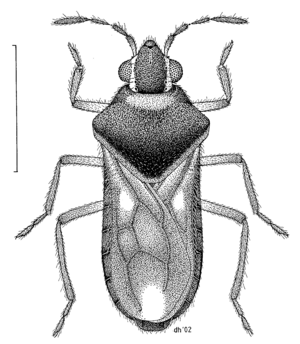Microvelia macgregori facts for kids
Quick facts for kids Microvelia macgregori |
|
|---|---|
 |
|
| Scientific classification | |
| Genus: |
Microvelia
|
| Species: |
macgregori
|
Microvelia macgregori is a tiny insect, a type of true bug. It belongs to the Veliidae family, often called "water striders." This bug lives on the surface of freshwater in New Zealand.
Contents
Meet the Microvelia macgregori
What Does It Look Like?
The Microvelia macgregori is a very small bug. It is only about 2 mm (0.08 in) long. That's about the size of a small ant!
Where Does It Live?
This special bug is only found in New Zealand. Scientists say it is "endemic" to New Zealand. It lives on the surface of water in many different places. You can find it in lakes, ponds, and slow-moving parts of rivers and streams.
In higher, mountain areas, you might see Microvelia macgregori with wings. But in lower, flatter areas, most of these bugs do not have wings.
How Microvelia macgregori Behaves
Moving on Water
Members of the Veliidae family are known as "water striders." They move across calm water by walking or "rowing" with their legs. They can also climb onto wet rocks or muddy banks.
The Microvelia macgregori spends most of its time on the water's surface. It moves in a jerky way, like it's dancing! It will move in one direction, then quickly turn and go another way. Sometimes it stops for a bit before moving again. If many bugs are on the water, they all move on their own. They don't move together.
What Does It Eat?
The Microvelia macgregori is a hunter and a scavenger. This means it eats other insects and also finds dead ones to eat.
Hunting Live Prey
When a larger insect accidentally falls onto the water, it struggles to get free. This struggling makes tiny vibrations in the water. These vibrations attract the Microvelia macgregori bugs.
The first bug to arrive will slowly extend its rostrum, which is like a long snout. It tries to push its stylet (a sharp, needle-like part) into the struggling prey. If the prey keeps fighting, the bug will back off. But it will try again when the prey calms down.
Other bugs might arrive and also try to feed. They all try to push their stylets into the prey. If there are only a few bugs, they might pull out their stylet and try a different spot. If many bugs arrive, it can get crowded! Latecomers might try to push their way in. The bugs already feeding might kick at the intruders with their back legs.
Finding Dead Prey
Dead insects floating on the water don't make vibrations. During the day, a Microvelia macgregori might see a large dead insect. But smaller dead insects are usually found by accident. If one bug finds a small dead insect, its movements might attract other bugs. At night, bugs find dead prey of any size by accident.

